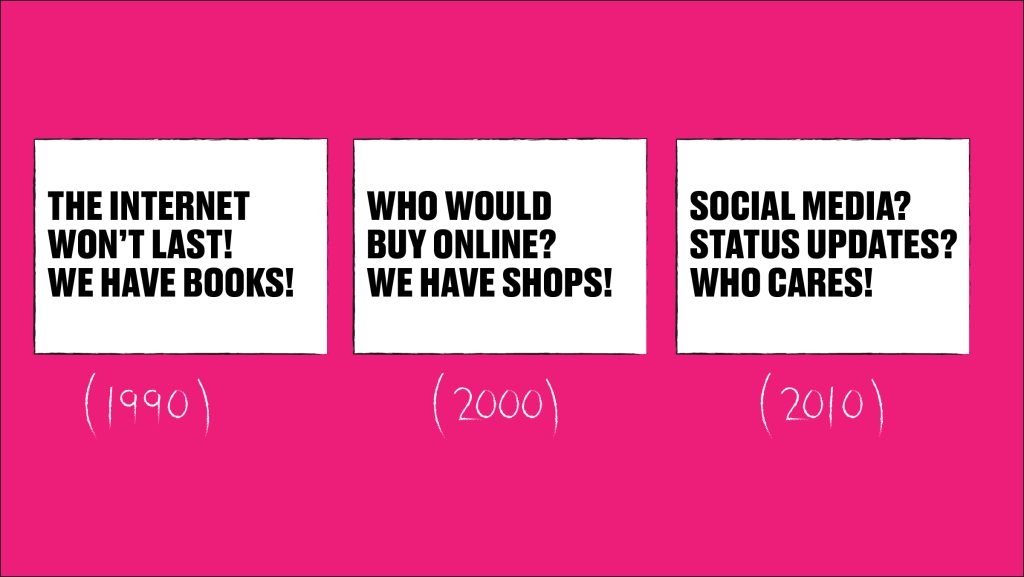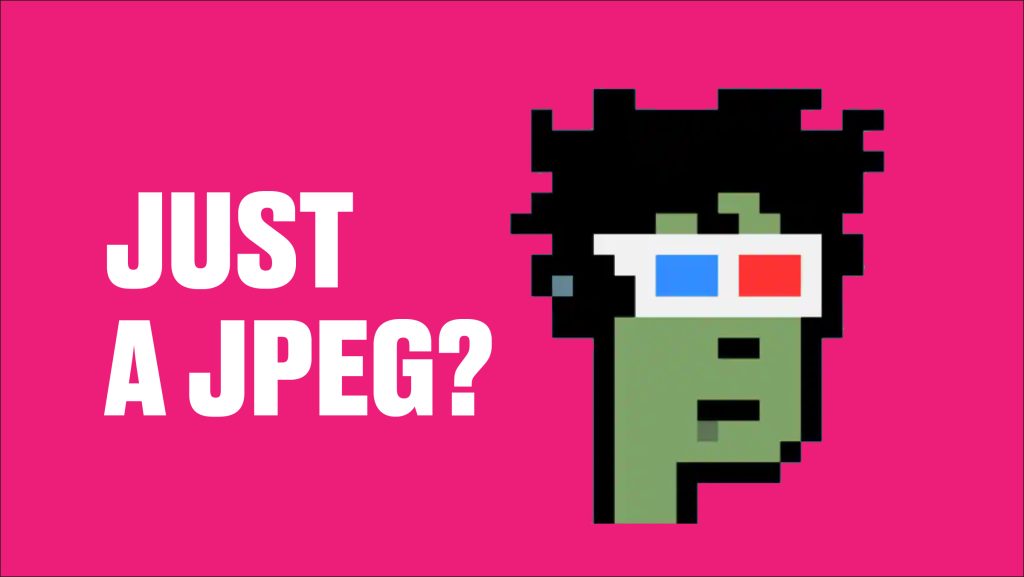This week, GW+Co Founder and Principal Gilmar Wendt sat down with designer Christian Kett and digital evangelist Gavin Anderson to talk all things Web3, from blockchain and cryptocurrency to NFTs and Bruce Springsteen (obviously).
Gilmar: Hello, and welcome to this episode of the GW+Co conversation series, Hidden Transformations. This is where we look at trends and developments that may be well-known but which are not always clearly seen. It reflects our belief that big change can often hide in plain sight. That’s why including diverse perspectives on any business issue is a competitive advantage – it helps you recognise the opportunities within Hidden Transformations.
Today we’re talking about the way the web is going. Called Web3 – which, rather confusingly, is not the same as Web 3.0 – there’s a lot of rapid development in an area that we all know is essential to business success, but which is often complex and full of obscure jargon.
In the studio with me are Christian Kett (top left) and Gavin Anderson (top right). Christian is a designer and also a drummer, with a long-standing interest in all things digital. He tells me he spends his evenings building virtual 3D houses. Alongside Christian we’ve got associate partner Gavin, who is known as a digital guru in India, the UK, South Africa, and beyond. Gavin works with us on digital insight and strategy projects.
Let’s start with an outline of what we’re talking about here. What is Web3 and why should we care about it?
Gavin: The question is more about why people would use Web3, because it’s a technology platform rather than a single use item. Today we might associate Web3 with cryptocurrency, with Elon Musk and Dogecoin and crashes in the market. But blockchain, the thing that underpins cryptocurrency, is a core Web3 technology and it’s going to pop up in our lives in many different ways. That’s the ‘hiding in plain sight’ bit. Back in the ‘80s you might have said ‘why would we need a website?’ Or in the early 2000s it was, ‘we’ll never need a mobile app’. Now people are saying, ‘oh, we’ll never do Web3’. It’s one of those things that seems to change suddenly, like it did with e-commerce. The High Street was destroyed by online retail, mobile first did the same for banking and now it’s eating into health care. With Web3, the threat for businesses is that in two or three years they might wake up and all their competitors are using it. It will become an industry standard, but many firms won’t even have got off the blocks.
 Change has always been met with scepticism.
Change has always been met with scepticism.
Gilmar: So, web 1.0 was basic websites, web 2.0 was mobile apps…
Christian: Web 1.0 was very much about basic read and write, managing documents. It was effectively a library. Web 2.0 was more participative, with social media and interactive online experiences on sites like Amazon, eBay, Facebook, and so on. Web3 is a new era where, at least in theory, consumers can take back ownership of their data. That’s the promise of the blockchain technology that cryptocurrencies are based on. It allows for accountability and interoperability, and it allows consumers to have a consistent and secure online identity. Web3 enables you to be your own data custodian, you don’t need to trust anyone else.
Gavin: The database analogy is a good one, and possibly the simplest way to describe Web3. If you imagine a database at the moment, it sits on one machine, it’s centralised. You input the information and it ends up in a single place. If you want to add more information, you’ve got to go to the owner of the database, they’re essentially a gatekeeper. Web3 is decentralised. Lots of pieces of information are bundled together into a block, and blocks are then chained together using cryptography – hence ‘blockchain’ – and it gets validated by thousands of other Web3 users around the world. So there’s no single gatekeeper anymore.
Christian: When you say ‘users’ it’s actually machines. And I think that’s why it’s hard to describe Web3 without an understanding of what goes on behind it. For example, if you look at Bitcoin, the cryptocurrency widely associated with Web3 because it was the first real use of blockchain, it’s basically a public ledger. It’s an entry of transactions, and when you interact with it, your activity is recorded and approved by machines that validate each transaction using cryptography. There was a lot of noise about NFTs recently as well, but an NFT is just a kind of digital receipt. It can be for anything – a piece of art, a house, an MOT certificate, a JPEG. What’s important is that it’s recorded on the blockchain – an unchangeable database – therefore, anyone who wants to check can tell it’s genuine. Each end user has a wallet with a unique blockchain address, but it doesn’t store their personal details so it’s more or less completely anonymous.
 A non-fungible token, or NFT, called CryptoPunk #8857 sold for 2,000 ether, or $6.63 million.
A non-fungible token, or NFT, called CryptoPunk #8857 sold for 2,000 ether, or $6.63 million.
Gilmar: That’s why Lenzing, the Austrian textiles manufacturer and a GW+Co client, are using blockchain.
Christian: Yes, Lenzing use blockchain technology to verify their products at each stage of the supply chain. What they are doing is certifying fibres, from their place of origin right through to when they end up in a consumer product. You can look at the blockchain and see all of those stages. It’s publicly available and makes the origin of the product and its journey to the consumer completely transparent.
Gilmar: Exactly, because Lenzing are champions of circularity in the clothing industry. The sourcing and traceability of materials are absolutely key to what they’re doing. Gavin, a moment ago you said everyone is going to be using Web3 in two or three years. Why?
Gavin: Because of that whole area of proof of authenticity, proof of ownership. For instance, fake brands are a big challenge for perfume manufacturers. If you buy a bottle of Chanel No 5 you want to know it’s the real deal. In Web3, you can scan it and see it’s been registered on a blockchain. You’ll be able to see it was made by Chanel in France, it’s bottle number 45,678 or whatever. Or let’s say Bruce Springsteen announces a world tour, and I’m in the marketing department at Levi’s. I haven’t got all the email addresses of everybody who ever went to a Bruce Springsteen concert, but I know they might like denim if they’re a fan of the Boss. I can offer a 20% discount to every crypto wallet belonging to someone who went to a Springsteen gig, which I can validate because their ticket was an NFT – digitally created and sold via the blockchain. Imagine the conversion rate, compared to how we do it today.
 Web3 will flip the marketing model as we know it.
Web3 will flip the marketing model as we know it.
Gilmar: So this kind of inverts the existing marketing model of segmenting audiences based on demographics, which are really just assumptions about people. You don’t need to know that, say, someone is a 40-something home owner with 2.2 kids who goes to Starbucks and likes motorbikes. But, if they went to the Springsteen gig, you can reach them via their wallet on the blockchain without making assumptions about their lifestyle, or intruding on their privacy.
Gavin: It’s a lot less intrusive, because the offer is associated with a verifiable behaviour, not with assumed characteristics. Companies will search for wallets with specific transactions to target the Springsteen concert goer who likes Harleys, eats pine nuts and goes on Caribbean holidays, or whatever. All the personas, demographic segments, all that becomes irrelevant.
 Web3 enables us to be our own data custodian.
Web3 enables us to be our own data custodian.
Gilmar: With NFTs, then, you are pulling content to you. Traditional marketing pushes content at you.
Gavin: That’s right. There’s an interesting development in the US where the NFL, which runs the professional gridiron football game, wants fans to be able to keep and trade digital ticket stubs in the way they do with paper tickets. During 2022 the NFL gave away a million NFTs of ticket stubs to fans who bought their ticket from one of NFL’s official partners, and they’re planning to expand the use of NFT ticketing.
Gilmar: So, if I buy an NFT ticket for the Super Bowl using my blockchain wallet, but I really don’t want anyone else to know… for whatever reason… can I be completely in control of who knows?
Christian: I think that’s where the privacy kinks will be worked out, because you can already do it with crypto currencies. There are services that scramble your address and make it private, although they’re quite ‘techy’ at the moment. I think there’ll be a more mainstream way of doing it in future. As Gavin said earlier, we’re early on in this and it’s something that will evolve and emerge.
Gilmar: Right, ok, I’m excited now, with my Super Bowl NFT tickets, and my Springsteen world tour tickets, maybe I’ll get some virtual popcorn to go with them! It’s a pleasure discussing these developments with you, thank you Christian and thank you Gavin. I’m looking forward to sharing more insights from the GW+Co studio, and bringing all this expertise and experience to our work with clients. If you’d like to know more about how we do that, just drop me a line – gw@gilmarwendt.com
See you next time!
What’s next?
Want to know more about GW+Co? Have a chat with Olivia
Have a question? Ask a question of one of the authors – Gavin or Christian
Have a strategic problem? Walk with Gilmar

